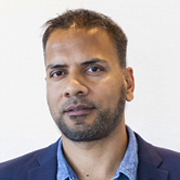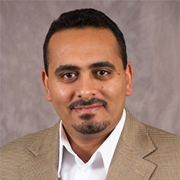November 1, 2018
Christopher Saldana and Nagi Gebraeel from the Georgia Institute of Technology, and Jean Lau from Hitachi Vantara join Sudhanshu Gaur of the Global Center for Social Innovation – North America, to discuss the challenges and opportunities for Hitachi in collaborating with customers and academia to benefit society worldwide through industrial IoT.Sudhanshu
Industrial IoT is the driving force behind the digital transformation that we see across different industry segments. Many of the experts have dubbed it the "Fourth Industrial Revolution." IoT is changing the way businesses, governments, and consumers interact with the world around us. The interest in this area is being matched by the investment that we see in the IoT space. For example, in manufacturing the investment level is expected to be close to a quadrillion dollar worldwide by around 2020. I’d like to get your thoughts on where you see industrial IoT heading.
Chris
Currently, there’s a push by the US government to bring manufacturing activities back to this country. One way that will happen is through enhanced productivity. The investment in the area of industrial IoT in manufacturing is echoed in US government initiatives, and there’s a lot of collaboration with universities and industrial partners in these areas. A main focus of the Digital Manufacturing & Design Innovation (DMDI) Institute is on industrial IoT for discrete manufacturing. The relatively new Smart Manufacturing Network, a national network for manufacturing innovation, focuses on continuous manufacturing. Both are trying to develop solutions that can be implemented in the manufacturing space to improve productivity.
We also need to pay attention to the rise of distributed manufacturing. There’s an expansion in the area of "Uber" manufacturing, where companies with brokerage services use IoT technologies to link companies to customers wherever they are.
Nagi
My perspective is that industrial revolutions are defined by the impact that they leave on people’s lives – how disruptive they are to employment patterns, how much they accelerate innovation, and how they impact national economies. Industrial IoT is guiding and shaping this Fourth Industrial Revolution. Many of the constituent technologies have existed since the 1960s, so in themselves are not necessarily groundbreaking. The key question is, "What’s new?" In my opinion, it’s the data and what we can do with it. The ability to acquire, communicate, and store data using inexpensive technology, and being able to visualize and analyze data using sophisticated tools like machine learning and analytics-based artificial intelligence, is unique to today’s industrial ecosystem.
Jean
Absolutely. We all agree that we need to leverage the technology and make improvements on using the greatest and latest technology. A question I have is: How are we going to change people’s mindsets about adopting the technologies and solving the problems on the factory floor?
Chris
That’s a great question. We work with customers every day who didn’t grow up with digitally-enabled manufacturing. Historically, data was kept inside its originating unit and was not shared with the larger enterprise. Now, getting buy-in from stakeholders who aren’t familiar with the problem-solving benefits of a digitally-enabled environment is one of the biggest barriers. But people are starting to trust the use of IoT technologies. If we can unlock this data to improve processes, the benefits can be significant to society because we are going to start seeing more manufacturing investment in these new models.
Sudhanshu
The technology is there, but often there is skepticism from the end customers, especially on the shop floor from people who have been working in the industry for decades. These may not all be IT-savvy people. How do we make it easier for them to use the technology? It’s made more difficult by the fact that industrial IoT, right now, is not a technology that works out of the box. There’s an engagement process, there’s a phased deployment, and it takes time to discover the issues and build solutions that can deliver the right outcomes. Let’s talk about these challenges.
Chris
We’re seeing challenges in deploying IoT at many shops – from large enterprises to small manufacturers. I’ll pick two deployment challenges: one is cost, and the other in implementation. First, manufacturers look at hardware solutions in terms of their return on investment or ROI. A lot of the technologies are fairly expensive. For example, look at the investment decision to enable a digital solution for a machine tool that has been in service for 20 years – which is only half the lifespan of that machine tool. It could stay in service for another 20 years. The question is: What are we getting for the cost of this investment?
The second challenge is implementation. We can develop solutions that are flexible enough for multiple customers. But in the last mile for implementation on the shop floor, how do you get their data into the cloud? That, is very specific to a customer. If you’re a job shop that works on sensitive products, like in the military or the aerospace or biomedical industries, the challenges are around implementation, especially for security, and the costs of specific machines that are used for sensitive operations.
Nagi
I’d like to look at the two ends of the spectrum. At one end is the data and the other end is the customer’s culture, including a resistance to change. From the data side, I’m talking about data integration. You have many important data sources that are owned by different entities within the enterprise. These entities don’t want to share their data because of a sense of ownership. We need to overcome those hurdles and convince customers to take a holistic view of the enterprise. When you integrate data from across the enterprise, you reveal previously unseen correlations and relationships that can be leveraged to improve decision-making.
At the opposite end of the spectrum, there is a resistance to change. You can implement a PoC that is successful, but there are face barriers in deployment and implementation across the enterprise because of this resistance to change by the operators on the shop floor. We have to educate the operators and keep them involved and engaged. It’s not something that can be resolved immediately – it’s a process. We faced these challenges before with the introduction of lean manufacturing. It took time and a lot of effort, but there has to be buy-in across the organization.
Jean
I agree with Nagi 110%. It’s a transformation – and it’s not just a technology transformation, it’s a cultural transformation. How do we sway the performer that the technology will take the industry to the next level? You mentioned data isolation. Normally, the IT data is owned by the IT team and the OT data is owned by the OT team. When we have the technologies together, it has to be implemented in the processes and integrated in the IT and OT personas as well as integrated with the data that provides the result. It’s not the operator in isolation anymore. Overcoming that challenge, it is a big deal.
Sudhanshu
In my experience with customers, it’s not so much about the technology as it is about how to make the users of the technology believe in the technology – that it can actually deliver and help solve their problems. Executives buy into the vision. The resistance we see is on the shop floor. We need to educate people not only about the technology, but how it actually works and why they should trust it.
Sudhanshu
When it comes to integrating the data, the challenge is that there are no standard data models or communication protocols to allow scalable aggregation of diverse sets of data originating from heterogeneous selection of assets. You may have a solution that works for one customer, but if you go to another customer everything changes – different IT system, different manufacturing system – everything changes. If you look at IoT device manufacturers, there is a complete lack of agreement on standard data and one has to deal with a myriad of IoT protocols. This needs to be addressed before we can see large scale deployment of industrial IoT solutions. So, the question is, what can we do to help overcome this challenge?
Chris
Even within individual sectors there are varying degrees of connectivity and different standards that have been implemented for deploying industrial IoT or connectivity to the cloud. We need the active involvement of people in the standards communities who have an interest in deploying these advanced algorithms for consuming data in different sectors.
One way we’ve been dealing with the standards question in practice, is to develop interfaces and translators that are consuming data and translating data into open format. Whether it is on the developer side of the IoT technologies and the machines themselves, or on the software-systems side for consuming this data and putting it out into a format that can be visualized and brought in with asset management systems, the ability to remain open in terms of the standards that are deployed is very important.
Nagi
Education is a big component in this process. There’s a disconnect in the language, in the expectations, in the understanding of all parties. The burden lies on the technologist to educate and set expectations. This communication can be through workshops, review sessions, and certificate programs; for example, a three-day workshop that practitioners must complete to be Level One for analytics or reliability, or something comparable.
Then, this might be augmented with a PoC where practitioners and technologists implement what they’ve learned. This will foster confidence in the benefit of the technology. At that point, you have your confidence, you’re speaking the same language, and you’re ready for deployment. Deployment now becomes a process instead of a challenge.
Jean
Removing complexity from the customers’ perspective will increase adoption. Even in just talking about standards, we’re talking about so many different protocols, different ways of connecting to data, and different technologies. What if we hide all the complexity of the technology side from the users so they don’t have to worry about the underlying communications protocol or how to get data? If we provide an interface for the APIs, it makes it easier to use. With the technology that we have, we can deliver solutions that are easy for the customer to adopt and turn that into a result. It is a big challenge for us, but reducing the challenge on the customer side will facilitate adoption.
Chris
That’s true. Look at the consumer loyalty sector and what’s going on with Amazon and Google and Apple in terms of home devices. The reason they’re doing so well is that – from the customer perspective – everything just works. Obviously, there’s a lot of work that the customer doesn’t see. If we can separate the users from the product complexity but make it so that developers can maintain these systems and leverage flexibility that is not platform-specific, then I think we are building for success.
Sudhanshu
If we could achieve in manufacturing what Jean describes, we’d have a seamless experience for our customers and they’d see the benefits right away. There are a couple of substantial challenges. First, if you do a quick PoC, you might not be able to see the true value of IoT and big data because you will be tapping into a small data source. And without seeing the results, the customer is not going to give you access to more data. Second, when we are able to show the benefit and deploy a factory-wide system, the challenge then is how to deal with security and other issues. That’s something that will have to be addressed.
Nagi
In terms of the ROI or PoC, you’re in trouble if you can’t demonstrate the ROI in a short time. Scoping out the right PoC and defining expectations is key. Another challenge is around data security. The tendency is to have cloud-based analytic solutions deployed within the customer’s own cloud. If they have a cloud in place, all you have to do is manage your solution within their cloud, and there won’t be a lot of cybersecurity problems. But not everyone has their own cloud. The issue is often about data security in the international realm. For example, this appears pervasively in the energy sector. Countries do not want to share data so where the data resides is important. Control of the data is becoming increasingly constrained.
Chris
It’s a big concern for everyone, big or small, private or public. If a government is involved, the military is asking the same questions as the enterprise. They also have concerns about security around the most sensitive parts of the enterprise in terms of where the data is stored. It’s a business decision. A lot of companies are still focused on keeping information on site, but we have to question whether this is the right way to do it. You might want to push some of this information out so that you don’t need to store it and you can take advantage of these technologies.
Sudhanshu
What is needed from companies like Hitachi for a joint collaboration to push forward the industry of IoT?
Chris
We’re involved in training the next generation of people who will be implementing solutions and setting visions for deployment of technology. Involvement with universities like Georgia Tech and with technical colleges is very important so we can understand the technical capabilities of the students and help define what their interests are and what skills are needed. These engagements are very beneficial. We also work with companies that are looking for people who are involved in platform solutions for analytics.
Nagi
Analytics and industrial IoT are still in their infancy. The talent we need is not only at the undergraduate level, but also at an advanced level–with master’s degrees and at the PhD level. Attracting students to the industrial ecosystem requires nurturing relationships with them through the advanced degrees through sponsorship and internships, by having them work on real data from a company like Hitachi – driving their master’s thesis or PhD thesis around a problem that is relevant to the company. Building relationships with this talent before they enter the workforce is a big driver for attracting them and securing their loyalty. And there’s a lot of competition because that’s the way talent is currently being acquired.
Jean
Engaging and collaborating with the students in the universities to give them more exposure to the real world is practical. They need to know that we are not just developing technology but work closely with partners who are delivering real solutions and products to customers. How do we help expand that exposure to the universities and the students to bring them closer to the real world? That will help everyone and there will be a huge benefit from working together.
Sudhanshu
I completely agree. Universities have always excelled at IT, but what they have lacked is access to real-world data and a platform to test their models and theories. Industrial IoT is a perfect opportunity for companies like Hitachi to engage with academia on this journey of the industrial revolution. We should spread awareness of the positive societal impact that we can create with industrial IoT.
This is the third in a series of conversations focusing on industrial IoT, led by Hitachi’s Insights Laboratory. Previous conversations focused on digital transformation and industrial artificial intelligence. Future articles will address related topics such as the role of artificial intelligence in transforming mobility. Through co-creation of customer-driven solutions, Hitachi is expanding the boundaries of innovation. Partnering with customers and educational institutions worldwide, Hitachi strives to help resolve issues facing organizations and society – envisioning a better tomorrow.
(As at the time of publication)

Sudhanshu Gaur, Ph.D.
Director
Hitachi America, Ltd.
Global Center for Social Innovation–North America
Sudhanshu heads the Digital Solution Platform Laboratory at Hitachi America R&D, which incubates Industrial IoT Edge solutions through customer co-creation approach, working closely with engineering and marketing teams from Hitachi Vantara. He has demonstrated success in incubating IoT solutions for Manufacturing and Transportation use-cases from ideation phase to real-life deployments.
Sudhanshu is a Senior Member of IEEE. He has over 60 patents and is the author of several peer-reviewed publications in wireless communications including a book on heterogeneous networks in LTE-advanced. He holds a Ph.D. degree in Electrical & Computer Engineering from Georgia Institute of Technology, and received his master of science and bachelor of technology degrees from Virginia Tech and the Indian Institute of Technology, Kharagpur, respectively.

Jean Lau
Vice President, Product Management and Engineering,
Industrial IoT and Edge Computing
Hitachi Vantara
Jean leads product management and engineering in Hitachi Vantara, responsible for Edge strategy, product roadmap and delivery. With over 25 years of success in digital transformation, management, application development and software engineering across multiple industries. Prior to joining Hitachi, Jean was Vice President of Engineering and Technical Product Management in GE Digital, where she has demonstrated success in driving digital transformation for GE.

Assistant Professor
Manufacturing
The George W. Woodruff School of Mechanical Engineering
Georgia Institute of Technology
Dr. Saldana’s research is focused on digitally-enabled qualification and process modeling tools for advanced manufacturing. His research has been supported by industry and government (e.g., DOE, DMDII, NIST, ARO, NSF, DARPA, ARL, etc.). He earned his doctorate at Purdue University and has been recognized with several awards, including NSF CAREER, SME Outstanding Young Manufacturing Engineer and R&D100 Technology Awards.

Professor
Stewart School of Industrial and Systems Engineering
Georgia Institute of Technology
Dr. Gebraeel's research interests lie at the intersection of industrial Predictive Analytics, Machine Learning for enhancing asset management and optimization. He holds the Georgia Power Early Career professorship and serves as an associate director at Georgia Tech's Strategic Energy Institute with the responsibility of identifying and promoting research initiatives and thought leadership at the intersection of Data Science and Energy. He is also the director of the Analytics and Prognostics Systems laboratory at Georgia Tech's Manufacturing Institute.
Dr. Gebraeel was the former president of the Institute of Industrial Engineers (IIE) Quality and Reliability Engineering Division, and is currently a member of the Institute for Operations Research and the Management Sciences (INFORMS), The American Nuclear Society (ANS), and The American Institute of Aeronautics and Astronautics (AIAA). He received his MS and PhD in Industrial Engineering from Purdue University in 1998 and 2003, respectively.